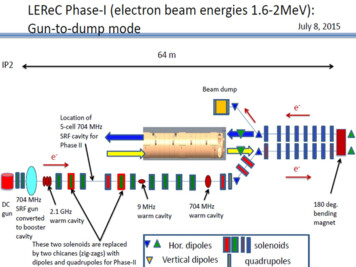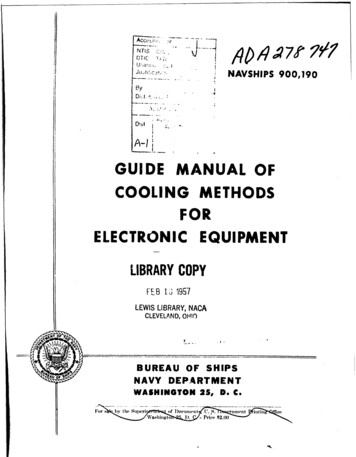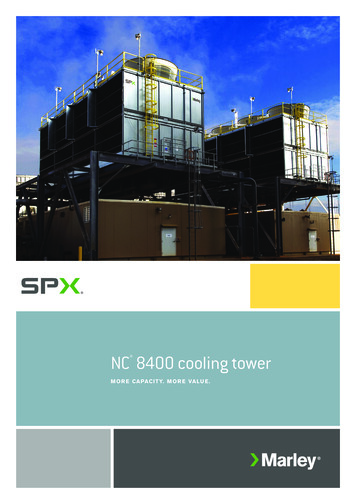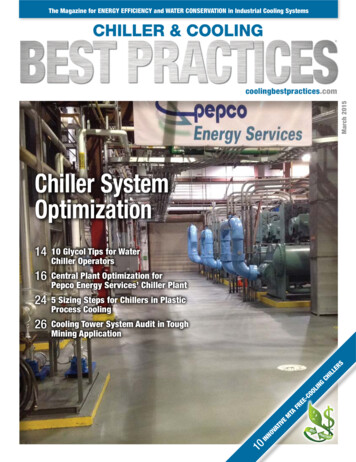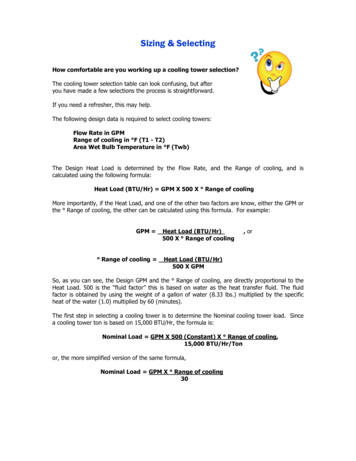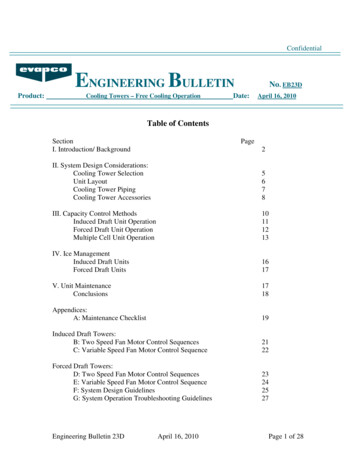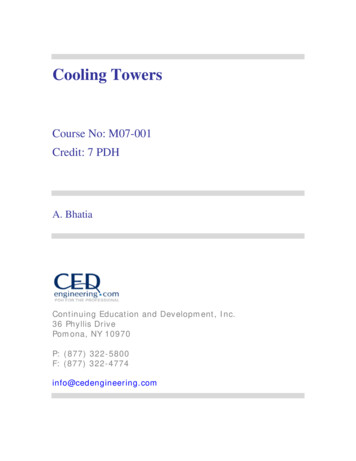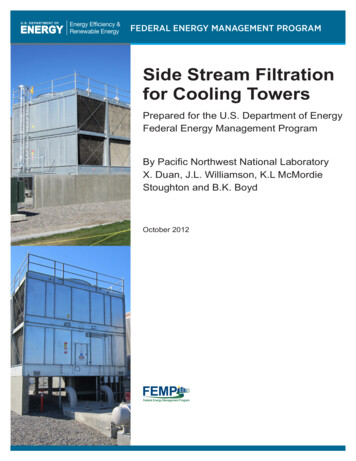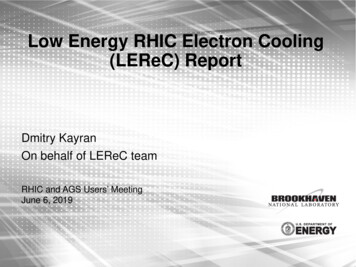
Transcription
Low Energy RHIC Electron Cooling(LEReC) ReportDmitry KayranOn behalf of LEReC teamRHIC and AGS Users’ MeetingJune 6, 2019
LEReC Project GoalsThe goal of the LEReC project is to provide luminosity improvement for RHICoperation at low energies to search for a QCD critical point (Beam EnergyScan Phase-II physics program).LEReC is first RF linac-based electron cooler (bunched beam cooling).To provide luminosity improvement with such approach requires: Building and commissioning of new state of the art electronaccelerator Produce electron beam with beam quality suitable for cooling RF acceleration and transport maintaining required beam quality Achieve required beam parameters in cooling sections Commissioning of bunched beam electron cooling Commissioning of electron cooling in a collider2
3RHIC @ BNL, Long Island, New York12:00 o’clock10:00 o’clockLEReCRHIC2:00 o’clock8:00 o’clock4:00 o’clock6:00 o’clockLINACNSRLEBISBoosterAGSTandems
LEReC inside RHIC tunnel atInteraction Region @ 2 o’clock (IR2)Transport beamlineInjection Section(DC photocathode Gun,SRF Booster cavity)Cooling sectionsLaser4
LEReC Accelerator(100 meters of beamlines with the DC Gun, high-power fiber laser, 5 RFsystems, including one SRF, many magnets and instrumentation)704 MHzCu Deflector CavityRF 04 MHzCu CavityInjectionbeam dump9 MHzCu Cavity704 MHzSRFBoosterCavityCathodeloadingsystem2.1 GHzCu CavityCOOLINGin Yellow RHIC ringeRHIC TRIPLETRHIC DXe-DCGunCOOLINGin Blue RHIC ring180 BendingMagnetExtractionbeam lineHigh-PowerBeamDumpLF solenoidQuad correctorBPM 2.4 IDHF solenoidTrim correctorBPM 4.8 IDTransport solenoidCorrector 3.8 IDBellowsERL solenoidCorrector 6.0 IDIon pump* NOT to scale5
Stages of LEReC Commissioning Phase 1: DC Gun tests(April-August 2017):(January-February 2018):DC Gun tests in temporary configurationDC Gun tests in final configuration Phase 2 (March-September 2018): Full LEReC commissioningGoals: Meet all required KPPs. Achieve high-current operation ofaccelerator. Achieve electron beam parameters suitable for cooling. Phase 3 (2018-2019): Transition to operationsGoals: Achieve required stability (energy, orbit) of electron beam.Develop necessary stability, ripple, intensity, orbit feedbacks.Commissioning of LEReC for operation at higher energies. Phase 4 (2019-2020): Commissioning of cooling – requires Au ionsat the same energy.6
LEReC electron beam parametersElectron beam requirement for coolingMeasured*Kinetic energy, MeV1.6*22.61.6, 2.0Laser pulse duration, psec40404040Bunch duration in cool. sect, psec40040020400Electron bunch (704MHz) charge, pC13017020050-200Bunches per macrobunch (9 MHz)303024-3030Charge in macrobunch, nC455-61-6RMS normalized emittance, um 2.5 2.5 2.51.6-2Average current, mA364745-5514-30RMS energy spread 5e-4 5e-4 5e-4 2e-4RMS angular spread in cooling section 150 urad 150 urad 150 urad100-200 urad2019 test RUN*) not at the same time7
Bunched beam electron cooling for LEReC Produce electron bunches suitable for cooling by illuminating amulti-alkali photocathode inside the Gun with green light using highpower laser (high-brightness in 3D: both emittance and energyspread). The 704 MHz fiber laser produces required modulations to overlapion bunches at 9 MHz frequency with laser pulse temporal profileshaping using crystal stacking. Accelerate such bunches with RF and use RF gymnastics (severalRF cavities) to achieve energy spread required for cooling. Deliverand maintain beam quality in both cooling sections. Electron bunch overlaps only small portion of ion bunch. Allamplitudes are being cooled as a result of synchrotron oscillations.
LEReC beam structure used in cooling sectionElectron Beam profileN ion 6e8Electron bunches:f SRF 703.5 MHzQ e 75 pC, I peak 0.18 AFWHM 400 psec0.21.42 nsecI, AIons structure:120 bunchesf rep 120x75.8347 kHz 9.1 MHzN ion 6e8, I peak 0.25 ARms length 12 nsec0.10 2 1021time, nsecLEReC Beam Structure30 electronbunches per ionbunch9 MHz bunch structureLEReC RHIC Beam Structure0.3Electron Macro-bunch0.20.20.2I, AI,AI, A110nsecLong ion buncheswith new 9MHz RF0.10.10.10.00 200-200 100-10000time,time, nsecnsec1001002002000 60-60 40-40 20-2000time,nsectime, nsec2040204096060
Photocathode production (in instrumentation building)On center 12mm active areaUsed 2017-18 commissioningCathode transfer cameracan hold up to 12 cathodesOff center 6mm active areaUsed during 201911
LEReC cooling section fully installed (2018 )
Transverse beam quality in cooling sections without ionsBunch charge 75 pCMovable slit and downstreambeam profile monito areinstalled at the beginning ofeach of cooling section
Longitudinal phase space measurement in RF diagnostic line1 macrobunch, 3 nC704MHz RF verticallydeflecting cavity6 macrobunches, 3 nC each First dogleg merger dipole is off Beam goes to RF diagnostic line 20 degree dipole produceddispersion Deflecting cavity produces timedependent vertical kickIn pulsed mode dueto beam loading effectfollowed bunches have lower energy
LEReC: First observation of electron cooling usingbunched electron beam (April 5, 2019)Bunch length time evolutionfor two Au ion bunches in RHICIon bunch #4 which is not being cooledIon bunch #2 is being cooledLongitudinal profilesof six ion bunchesEnergy of electrons and ions matched
Simultaneous cooling in both RHIC rings (Apr 26 )YellowCooled, heated and non-interacting bunchesBlueBlueBlueYellowYellow16
Most resent result of cooling in Yellow and Blue (May 31)In both rings: Cooled and non-interacting has thesame life time Cooled bunch is kept shorter Peak current significantly higher forcooled bunchlifetimeBunch lengthIon bunch profilesCooled bunchIon lifetimeIon bunch profilesNon-interactingCooledlifetimeCooled bunchIon lifetimeBunch lengthNon-interactingCooled17
First cooling (in Yellow) using high-current CW electron beam76 kHz mode for e-beam.Only single RHIC bunch is cooled.9MHz CW (50pC/bunch, 13mA)All 6 RHIC bunches are cooled.76KHz (left) - single ion bunch being cooled9MHz CW (right) operation - all 6 RHIC bunches are cooled
CW operation at 14 mA and simultaneous cooling in Yellowand Blue RHIC rings, 6 bunches in eachIon bunch length changes with and withoutcooling in both RHIC ringsLEReC currentIons Emittance in YELLOW ring76 kHzoperationNo Cooling9 MHzoperation
LEReC timelineMay 2015:LEReC project approved by DOE for constructionDecember 2016:DC gun successfully conditioned in RHIC IR2February 2017:Gun Test beamline installed in RHICApril-Aug., 2017:First Gun tests with beamJuly-Dec., 2017:Installation of full LEReC acceleratorJan.-Feb., 2018:Systems commissioning (RF, SRF, Cryogenics, Instrumentation,Controls, etc.)March-Sept. 2018:Commissioning of full LEReC accelerator with e-beamSept 2018 :All project Key Performance Parameters achievedOct.-Dec., 2018:Scheduled upgrades and modifications (NO beam testing)December, 2018:Gun Conditioning and HVPS tests without e-beamJan.-Feb., 2019:Restart operation with electron beam. Achieved e-beam quality suitablefor coolingMarch 2019:Start commissioning with Au ion beams.Matched RHIC/LEReC beams energies and trajectories in cooling sectionsApr 2019:First cooling in one ring then in both RHIC rings using 76 kHz bunchMay 2019:Cooling of 6 bunches in both RHIC rings using 9MHz CW LEReCJune 2019:Cooling optimization, studies effect to RHIC collision rate,Commissioning LEReC at higher energies20
Summary LEReC is the first electron cooler based on the RF acceleration ofelectron beam. We designed, built and commissioned state of the art electronaccelerator which provides beam quality suitable for electron coolingusing bunched electron beams. First electron cooling using bunched electron beams based on the RFacceleration was demonstrated. Ion bunches in both RHIC rings have been cooled simultaneouslyusing the same LEReC beam. An optimization of cooling and effects on ion beam lifetime is inprogress. The next step will be to show that the cooling enhances collisionrates in next year’s RHIC low-energy collisions. With a bunched beam electron cooling technique now experimentallydemonstrated, its application to high-energy cooling can open newpossibilities by producing high-quality hadron beams.21
AcknowledgementLEReC success would not be possible without teameffort and expertise of many people from variousgroups of the Collider-Accelerator and otherDepartments of the BNL.As well as FNAL, ANL, JLAB and Cornell University.Thank you!
LEReC teamhttps://www.bnl.gov/newsroom/news.php?a 215585
March-Sept. 2018: Commissioning of full LEReC accelerator with e -beam . Sept 2018 : All project Key Performance Parameters achieved . Oct.-Dec., 2018: Scheduled upgrades and modifications (NO beam testing) December, 2018: Gun Conditioning and HVPS tests without e -beam. Jan.-Feb., 2019: Restart operation with electron beam.
